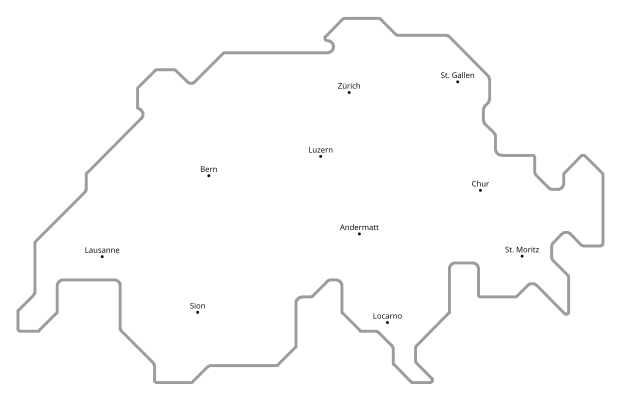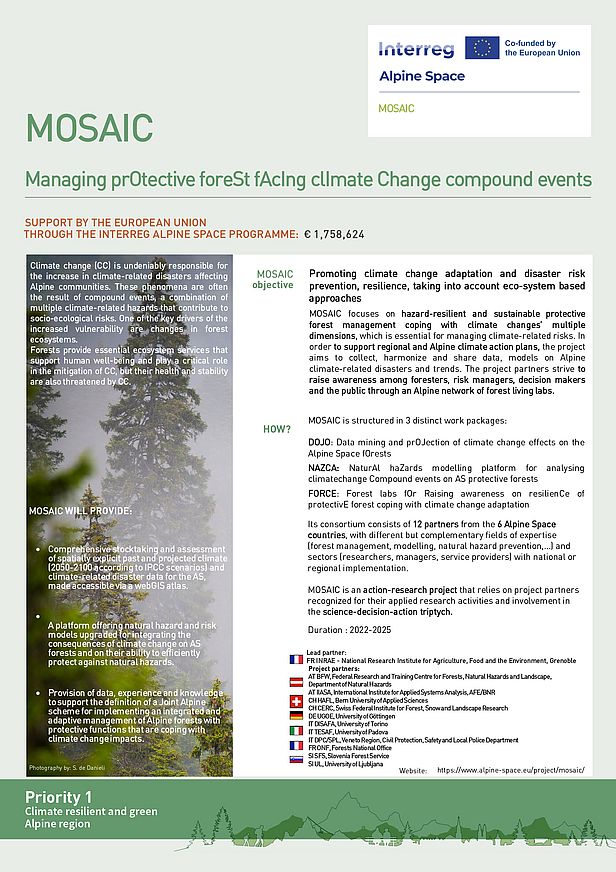Bark beetle infestation in protective forests: early detection and priority setting
2022 - 2025
Contents
earlyBEETLE: Early detection and processing of bark beetle damage in the canton of Grisons
Context

Over the past few decades, the European forest landscape has faced significant challenges due to periods of dry and warmer conditions. These climatic shifts have resulted in an increase in outbreaks of the European spruce bark beetle (Ips typographus L.), causing severe repercussions for Norway spruce forests. The pressure exerted by the bark beetle has far-reaching implications, particularly concerning protection against natural hazards and the delivery of other vital forest functions and services. Given that spruce dominates the mountain landscape in the canton of the Grisons, effective control and adaption measures become pivotal for this mountainous canton. The early detection of vulnerable and already infested trees is a crucial first step in planning and implementing successful strategies for dealing with this disturbance.
Objective
The earlyBEETLE project seeks to enhance existing research initiatives and ongoing projects at WSL, aiming to refine the early detection of beetle damage in the canton of Grisons. Furthermore, the project aims to systematically process and analyze the occurrence and spread of beetle damage.
To realize these goals, the earlyBEETLE project is structured around four complementary modules:
Module 1: Retrospective Analyses, Forest Structure and Tree Rings
This module involves the retrospective analysis for satellite data and tree ring data to assess past bark beetle infestations. The objective is to identify the factors influencing beetle infestations and enhance existing knowledge with newly collected data.
Module 2: Remote Sensing
Within this module, various remote sensing methods for early detection of bark beetle calamities will be evaluated, specifically in the Grisons mountain valleys. The research will focus on exploring suitable indices for identifying bark beetle infestations in mountain spruce forests, enhancing early detection capabilities.
Module 3: Bark Beetle Database
Implementing effective data collection methods and establishing a dedicated database will form a robust foundation for the enhanced and sustained monitoring of the bark beetle threat.
Module 4: Context-Dependent Management
This module seeks to asses the optimal integration of information derived from the earlyBEETLE project with other datasets. The objective is to prioritize measures in mountain spruce forests and utilize available resources efficiently for informed and context-dependent management.
earlyBEETLE will provide
Drawing on the current global knowledge base and leveraging the latest technological capabilities, the aim is to formulate a comprehensive strategy for the Office for Forest and Natural Hazards (AWN) that facilitates the early detection and management of spruce bark beetle infestations. This concept seeks to empower practitioners to address bark beetle challenges more effectively and enhance their understanding of the factors contributing to spruce trees susceptibility. Within the scope of this initiative, decision-makers will receive support to prioritize local measures in a strategic and meaningful manner.
Project Partner
The earlyBEETLE project is financed and supported by the Grisons Office for Forest and Natural Hazards (AWN).
MOSAIC
Our project participates to the project MOSAIC - Managing prOtective foreSt fAcIng clImate Change compound events, funded under the Interreg program - Alpine Space 2021 – 2027, administravely started the 1st of November 2022 and its kick-off meeting has been held in Innsbruck (19th-20th January 2023).
Context
Climate change (CC) is undeniably responsible for the increase in climate-related disasters affecting Alpine communities. These phenomena are often the result of compound events, a combination of multiple climate-related hazards that contribute to socio-ecological risks. One of the key drivers of the increased vulnerability are changes in forest ecosystems.
Forests provide essential ecosystem services that support human well-being and play a critical role in the mitigation of CC, but their health and stability are also threatened by CC.
Objective
The main goal of the project MOSAIC is to support the Alpine Space program objective: Promoting climate change adaptation and disaster risk prevention, resilience, taking into account eco-system based approaches.
Therefore, MOSAIC focuses on hazard-resilient and sustainable protective forest management coping with climate changes’ multiple dimensions, which is essential for managing climate-related risks. In order to support regional and Alpine climate action plans, the project aims to collect, harmonize and share data, models on Alpine climate-related disasters and trends. The project partners strive to raise awareness among foresters, risk managers, decision makers and the public through an Alpine network of forest living labs.
To fulfill its objectives, MOSAIC is structured in 3 distinct work packages:
- DOJO: Data mining and prOJection of climate change effects on the Alpine Space fOrests
- NAZCA: NaturAl haZards modelling platform for analysing climate change Compound events on AS protective forests
- FORCE: Forest labs fOr Raising awareness on resilienCe of protectivE forest coping with climate change adaptation
MOSAIC will provide
- Comprehensive stocktaking and assessment of spatially explicit past and projected climate (2050-2100 according to IPCC scenarios) and climate-related disaster data for the AS, made accessible via a webGIS atlas.
- A platform offering natural hazard and risk models upgraded for integrating the consequences of climate change on AS forests and on their ability to efficiently protect against natural hazards.
- Provision of data, experience and knowledge to support the definition of a Joint Alpine scheme for implementing an integrated and adaptive management of Alpine forests with protective functions that are coping with climate change impacts.
Consortium
Its consortium consists of 12 partners from the 6 Alpine Space countries, with different but complementary fields of expertise (forest management, modelling, natural hazard prevention,…) and sectors (researchers, managers, service providers) with national or regional implementation.
MOSAIC is an action-research project that relies on project partners recognized for their applied research activities and involvement in the science-decision-action triptych.
MOSAIC - Factsheet
MOSAIC - Details
- Total budget: 2.710.832,00 €
- ERDF support: 1.758.624,00 €
- Duration: 01/11/2022 – 31/10/2025
- Project website: www.alpine-space.eu/project/mosaic/
- Coordinator:
- FR INRAE - National Research Institute for Agriculture, Food and the Environment, Grenoble
- Project partners:
- AT BFW, Federal Research and Training Centre for Forests, Natural Hazards and Landscape,Department of Natural Hazards
- AT IIASA, International Institute for Applied Systems Analysis, AFE/BNR
- CH HAFL, Bern University of Applied Sciences
- CH CERC, Swiss Federal Institute for Forest, Snow and Landscape Research
- DE UGOE, University of Göttingen
- IT DISAFA, University of Torino
- IT TESAF, University of Padova
- IT DPC/SPL, Veneto Region, Civil Protection, Safety and Local Police Department
- FR ONF, Forests National Office
- SI SFS, Slovenia Forest Service
- SI UL, University of Ljubljana

